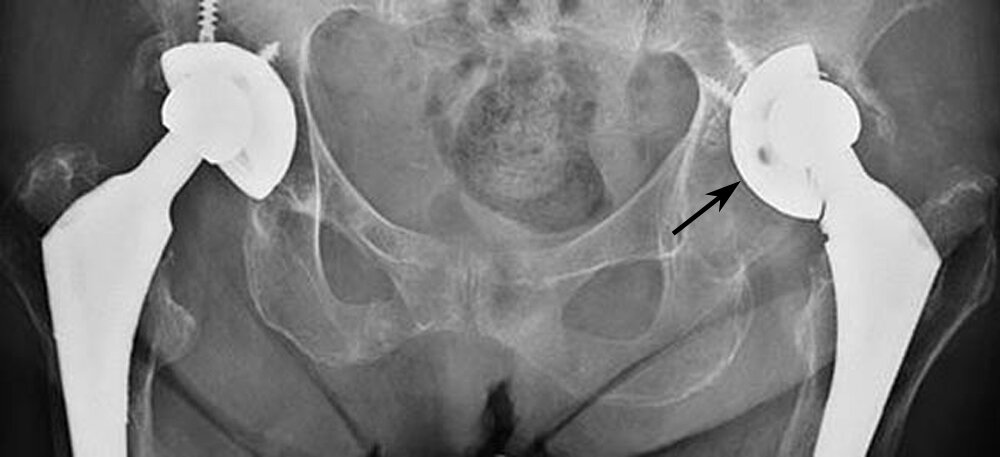Painful / Worn Previous Hip Replacement
Why does a total hip replacement fail?
Worn left total hip replacement with loosening and migration of the socket.
Total hip replacement is one of the most successful procedures in all of medicine. In the vast majority of cases, total hip replacement enables people to live more active lives without pain for many years, or for the rest of their lives. However, over time a hip replacement can fail for a variety of reasons.
Implant loosening: During the original operation the hip replacement implants are either fixed into the surrounding bone with bone cement, or have a coating which allows the body to grow onto the implants (cementless implants). With time and repetitive stress the bond between the implants and bone can weaken, and cause painful loosening of the implants.
Implant wear: The articulation (moving portion) of a hip replacement is made up of a metal or ceramic ball, and most commonly a plastic (polyethelene) socket. In older hip replacements the plastic liner can be worn away over time, creating tiny fragments of plastic debris within the joint. This debris causes an immune response which also attacks the healthy bone around the implants, causing it to deteriorate and leading to loosening of the implants.
Infection: This can be a problem with any surgical procedure, but is particularly problematic when associated with a prosthetic implant. Infections can either get into the hip joint at the time of surgery, or can enter at a later date through the blood stream (from an infection elsewhere in the body). Infection causes painful inflammation of the joint, and with time can lead to destruction of the bone and loosening of implants. Once stuck to the implants, bacteria cannot be eliminated with antibiotics alone and surgery is required to remove the implants.
Dislocation: A hip replacement is held in place by the muscles and ligaments around the joint. If the ball comes out of the socket this is called a dislocation. Dislocations can happen due to malposition of the implants, a correctly positioned implant wearing out, or if the hip is placed in an extreme position that it is not designed to safely reach. If a hip replacement dislocates repeatedly, further surgery may be required to stabilise the hip joint.
Fracture: This usually happens as the result of a fall or other significant injury. A fracture in the bone around a hip replacement can cause the implant to loosen.
Metal reaction: For a period of time in the early 2000’s some hip replacements used a metal ball and metal socket. In some patients the metal debris created over time causes a type of allergic reaction. This results in pain and inflammation, and may also cause systemic (whole body) symptoms.
How do i know if my hip replacement is worn out?
Most of the time a worn out hip replacement will present as new pain in a previously well-functioning joint. Unlike arthritis, this pain can be felt in a number of locations including the buttocks, groin, thigh or even knee. Pain is normally worse with activity, especially the first few steps when getting up from a chair or walking. Your hip may start to make clunking or grinding sounds, and even sublux (pop partially out of joint) or dislocate. In some cases there can be significant wear in a hip replacement with no or minimal symptoms. If your hip replacmement is over 10 years old it is a good idea to have it checked with x-rays every few years.
HOw is a worn out hip replacement investigated?
The best initial investigation of a problematic hip replacement are x-rays of the entire prosthesis. In many cases this is enough to identify the problem. Sometimes further investigations are required to make a diagnosis, or to help plan the revision (redo) surgery. Additional investigations may include:
CT scan
MRI scan
Bone scan or SPECT CT ( to show abnormal bone turnover around an implant)
Ultrasound scan
Blood tests.
What can be done for a worn out hip replacement?
The best treatment for a worn out hip replacement is a complex decision. Mr Gormack will need to review your medical records and imaging and make a full assessment of your individual circumstances. In some cases, even if wear and tear is seen on your x-rays, the most appropriate option could be to leave your hip alone. If the worn out implants are causing a significant problem or are at imminent risk of failure then further surgery may be required. Any operation to redo a hip replacement is called a revision. This can be anything from a simple change of parts to complete replacement of all implants. Please click here to learn more about revision hip replacement.

